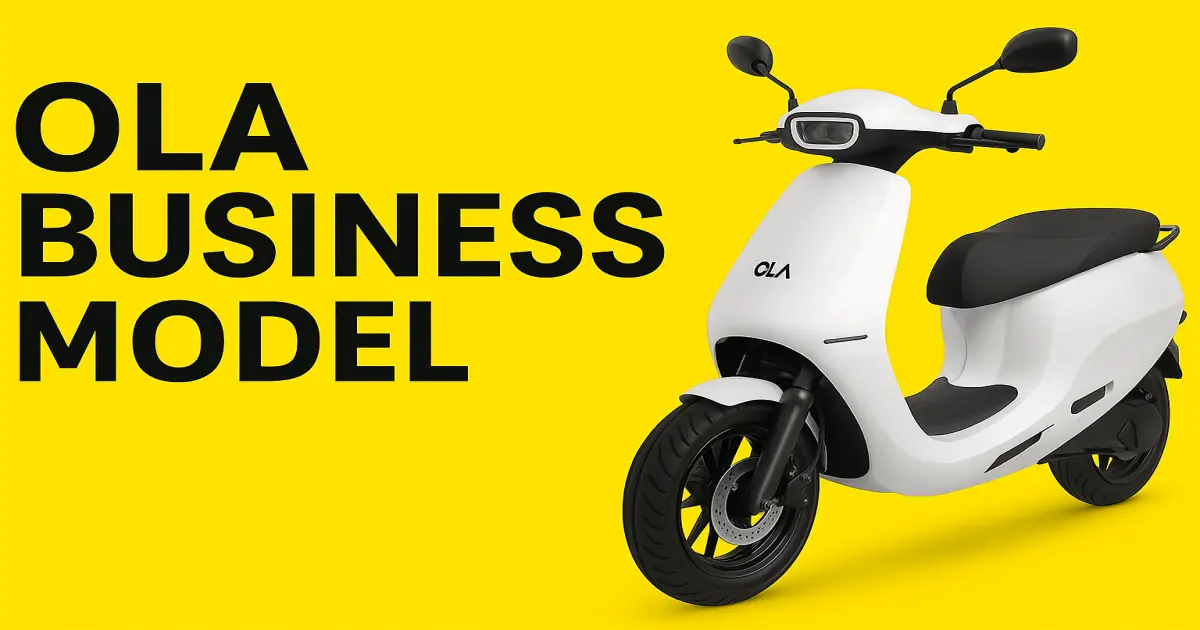India is witnessing remarkable progress and prosperity, with a strong focus on achieving its future goals in electric vehicle (EV) adoption. The transition to EVs is not just about technological innovation — it’s about reducing India’s dependence on crude oil imports, improving energy efficiency, and strengthening the country’s trade balance. As the EV ecosystem expands, it promises to make supply chains more efficient, promote self-reliance, and significantly reduce India’s trade deficit.
Among the companies driving this transformation, Ola Electric stands out as a leader in shaping India’s EV revolution. With an estimated 30% market share in the electric two-wheeler (E2W) segment, Ola has demonstrated strong, sustainable growth through innovation, scale, and forward-thinking strategy. To understand this success, it’s essential to explore Ola’s business model, growth journey, and financial performance.
About Ola Electric
In less than a decade, Ola Electric has evolved from an ambitious startup to one of India’s most influential EV brands. Founded in 2017, the company quickly positioned itself as a pioneer in sustainable mobility.
The launch of the Ola Future factory in Krishnagiri, Tamil Nadu, in 2021 marked a turning point. This state-of-the-art manufacturing facility became the foundation for Ola’s large-scale EV production. The same year, the company introduced its first electric scooter — the Ola S1 — which became a major success in India’s growing EV market.
In 2022, Ola strengthened its technological ecosystem by launching MoveOS, its proprietary vehicle operating system, and establishing the Battery Innovation Centre (BIC). These milestones set the stage for continuous innovation and deeper vertical integration.
The company’s momentum continued in 2023, with the launch of new models like the S1 Air and S1 Pro (Gen 2). The following year, 2024, was a landmark for Ola as it introduced the S1 X series, commissioned the first phase of its Gigafactory (Phase 1A), and successfully listed on Indian stock exchanges.
By 2025, Ola had already produced over 51,000 Bharat Cells during the trial phase, launched the Gen 3 scooter platform, and entered the electric motorcycle market with the much-anticipated Roadster series — further diversifying its product portfolio and strengthening its dominance in the EV space.
Future Plans: The Road Ahead
Looking forward, Ola Electric plans to expand into the electric motorbike segment with four major models — the Ola Roadster X+, Roadster X, Roadster Pro, and Roadster. These bikes are designed to deliver enhanced performance, advanced features, and a refined user experience.
The company has invested substantial time and resources in developing these products, positioning itself as one of the first movers in the electric motorcycle category — a segment that currently has limited competition in India. This expansion not only diversifies Ola’s portfolio but also opens new opportunities in the country’s fast-evolving EV market.
TATA MOTOR BUSINESS MODEL EXPLAINED
Ola Electric’s Financial Performance (FY 2024–25)
For the financial year ending March 31, 2025, Ola Electric reported ₹4,514 crore in total revenue from operations, compared to ₹5,010 crore in FY 2023–24.
1. Revenue from Contracts with Customers
- Sale of Finished Products: ₹3,893 crore (down from ₹4,604 crore last year)
- This primarily includes vehicle sales, which form the bulk of Ola’s revenue.
- Sale of Traded Goods: ₹105 crore (almost unchanged from ₹106 crore last year)
- Includes spare parts (₹91 crore), chargers, and accessories (₹14 crore).
- Sale of Services: ₹0 crore, compared to ₹88 crore in FY24.
2. Other Operating Revenues
- Vendor handling charges: ₹99 crore (up from ₹89 crore)
- Sale of scrap: ₹8 crore (slightly up from ₹3 crore)
- Subscription income: ₹18 crore (up from ₹13 crore)
- Government incentives: ₹390 crore (up sharply from ₹97 crore)
- Other revenue: ₹1 crore (unchanged)
Total other operating revenue stood at ₹516 crore, more than double the previous year’s ₹212 crore, mainly due to a rise in government incentives — reflecting growing policy support for India’s EV ecosystem.
Deeper Dive into Key Metrics
Financial Strength
- ₹4,514 crore in Revenue from Operations: Demonstrates Ola’s strong position in India’s EV 2W market, underlining high consumer acceptance and effective distribution.
- 17.9% Auto Gross Margin: Indicates efficient production, strong brand value, and premium customer perception in a competitive market.
Operational Excellence
- 17 Models in India’s Most Extensive EV 2W Portfolio: Reflects a wide customer reach — from affordable commuters to high-performance riders.
- 99% In-house Engineered Components: A major competitive edge that enables quality control, cost optimization, and faster innovation.
- 4,000+ Touchpoints Nationwide: India’s largest service and sales network, ensuring easy access and strong after-sales support.
Sustainability & Social Impact
- 73% Women Workforce in Factories: A ground-breaking figure that highlights Ola’s commitment to inclusivity and empowerment in manufacturing.
- 924.0 MT CO₂ Emissions Avoided: Showcases the company’s tangible contribution to sustainability by promoting clean energy adoption.
Conclusion
Ola Electric’s journey reflects India’s broader ambition of becoming a global hub for clean mobility. Through advanced technology, large-scale manufacturing, and an inclusive workforce, Ola has not only built a strong brand but also contributed significantly to the nation’s EV transformation.
As the company expands into electric motorcycles and enhances its battery innovation capabilities, Ola’s long-term vision is clear — to lead India’s transition to sustainable transportation and make the country a global powerhouse in the EV industry.
